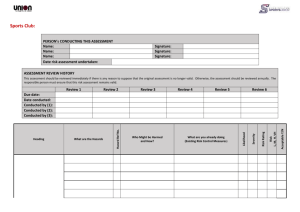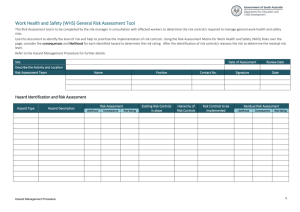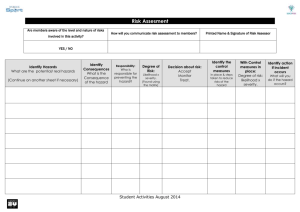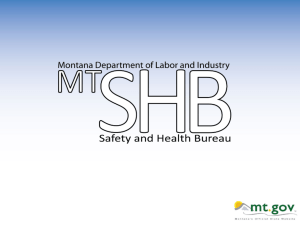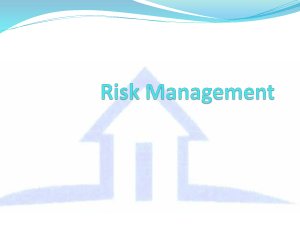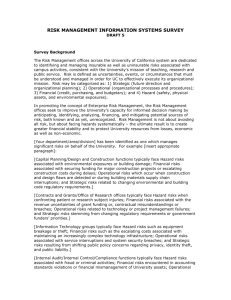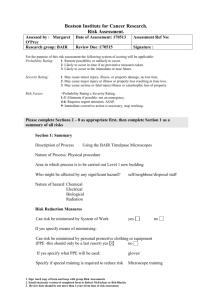Infection Control Risk Assessment Form
advertisement
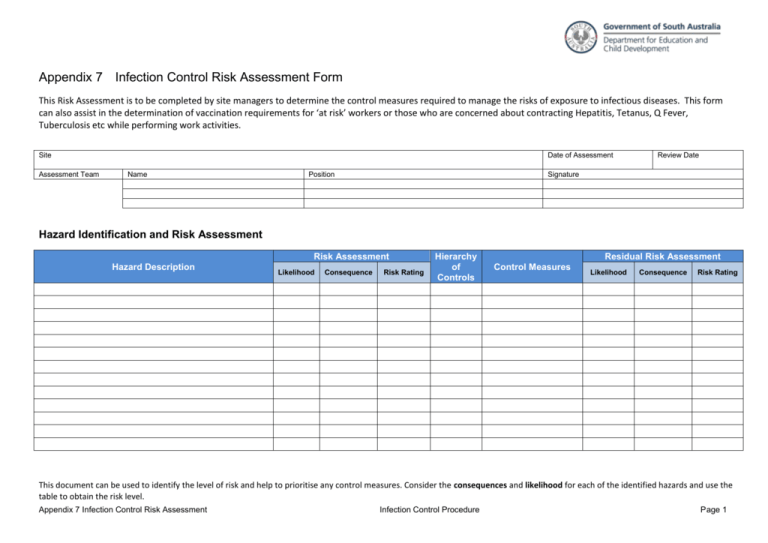
Appendix 7 Infection Control Risk Assessment Form This Risk Assessment is to be completed by site managers to determine the control measures required to manage the risks of exposure to infectious diseases. This form can also assist in the determination of vaccination requirements for ‘at risk’ workers or those who are concerned about contracting Hepatitis, Tetanus, Q Fever, Tuberculosis etc while performing work activities. Site Assessment Team Date of Assessment Name Position Review Date Signature Hazard Identification and Risk Assessment Risk Assessment Hazard Description Likelihood Consequence Risk Rating Hierarchy of Controls Residual Risk Assessment Control Measures Likelihood Consequence Risk Rating This document can be used to identify the level of risk and help to prioritise any control measures. Consider the consequences and likelihood for each of the identified hazards and use the table to obtain the risk level. Appendix 7 Infection Control Risk Assessment Infection Control Procedure Page 1 Risk Assessment Matrix for General Work Health and Safety Risks Likelihood Consequences 1 – Insignificant 2 – Minor 3 – Moderate 4 – Major 5 – Catastrophic Dealt with by in-house first aid Treatment by medical professional/hospital outpatient, etc Significant non-permanent injury. Overnight hospitalisation (inpatient) Extensive permanent injury Extended hospitalisation Death, permanent disabling injury High (H) High (H) Extreme (X) Extreme (X) Extreme (X) A- Almost certain to occur in most circumstances B- Likely to occur frequently Medium (M) High (H) High (H) Extreme (X) Extreme (X) C- Possible and likely to occur at some time Low (L) Medium (M) High (H) Extreme (X) Extreme (X) D- Unlikely to occur but could happen Low (L) Low (L) Medium (M) High (H) Extreme (X) E- May occur but only in rare and exceptional circumstances Low (L) Low (L) Medium (M) High (H) High (H) How to Prioritise the Risk Rating Once the level of risk has been determined the following table may be of use in determining when to act to institute the control measures. Extreme High Medium Low Act immediately to mitigate the risk.Either eliminate, substitute, isolate or implement engineering control measures. Act immediately to mitigate the risk. Either eliminate, substitute, isolate or implement engineering control measures. If these controls are not immediately accessible, set a timeframe for their implementation and establish interim risk reduction strategies for the period of the set timeframe. Take reasonable steps to mitigate the risk. Until elimination, substitution, isolation or engineering controls can be implemented, institute administrative or personal protective equipment controls. These “lower level” controls must not be considered permanent solutions. The time for which they are established must be based on risk. At the end of the time, if the risk has not been addressed by elimination, substitution or engineering controls a further risk assessment must be undertaken. Take reasonable steps to mitigate and monitor the risk. Institute permanent controls in the long term. Permanent controls may be administrative in nature if the hazard has low frequency, rare likelihood and insignificant consequence. Hierarchy of Control Elimination Substitution Isolation Engineering Controls Administrative Controls Personal Protective Equipment Remove the hazard at the source. An identified extreme risk does not allow scope for the use of administrative controls or PPE , even in the short term. An achievable timeframe must be established to ensure that elimination, substitution, isolation or engineering controls are implemented. NOTE: Risk (and not cost) must be the primary consideration in determining the timeframe. A timeframe of greater than 6 months would generally not be acceptable for any hazard identified as high risk. Interim measures until permanent solutions can be implemented: Develop administrative controls to limit the use or access. Provide supervision and specific training related to the issue of concern. (See Administrative Controls below) Controls identified may be a mixture of the hierarchy in order to provide minimum exposure. Eliminate the hazard. Provide an alternative that is capable of performing the same task and is safer to use. Isolates the hazard from people either by distance or physical barrier. Provide or construct a physical barrier or guard. Develop policies, procedures practices and guidelines, in consultation with workers, to mitigate the risk. Provide training, instruction and supervision about the hazard. Personal equipment designed to protect the individual from the hazard. Health & Safety Services June 2013 2 Corrective Action Plan Identified Hazard Risk Rating Control Measure to be implemented Residual Risk Rating Responsibility Completion Date Due by Risk control measures recommended agreed to / not agreed to (cross out what is not applicable) Comments Site Manager ……………………………………………………. Signature…………………….……………… Date / / ……….…………………………………. ………………….………………………. Consultation has occurred with the following: Name …………………………………………………………… Signature…………………………………… Date / / HSR……………………………………………………………… Signature……………………………………. Date / / Health & Safety Services June 2013 Comments ………………….………………………. ………………….………………………. 3

